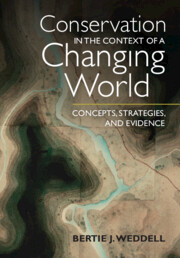Book contents
- Conservation in the Context of a Changing World
- Conservation in the Context of a Changing World
- Copyright page
- Dedication
- Contents
- Preface
- Acknowledgments
- Introduction
- Part I Maintaining Populations of Featured Species: A Utilitarian Approach to Conservation
- Part II Protecting and Restoring Populations and Habitats: A Preservationist Approach to Conservation
- 5 Historical Context
- 6 Central Concepts
- 7 Strategies
- 8 Strategies
- Part III Promoting Biocultural Diversity and Resilience: A Stewardship Approach to Conservation
- Postscript
- Appendix: Types of Ecosystems
- Bibliography
- Index
7 - Strategies
Protecting and Restoring Species
from Part II - Protecting and Restoring Populations and Habitats: A Preservationist Approach to Conservation
Published online by Cambridge University Press: 28 September 2023
- Conservation in the Context of a Changing World
- Conservation in the Context of a Changing World
- Copyright page
- Dedication
- Contents
- Preface
- Acknowledgments
- Introduction
- Part I Maintaining Populations of Featured Species: A Utilitarian Approach to Conservation
- Part II Protecting and Restoring Populations and Habitats: A Preservationist Approach to Conservation
- 5 Historical Context
- 6 Central Concepts
- 7 Strategies
- 8 Strategies
- Part III Promoting Biocultural Diversity and Resilience: A Stewardship Approach to Conservation
- Postscript
- Appendix: Types of Ecosystems
- Bibliography
- Index
Summary
The IUCN and many other organizations and governments maintain databases tracking the status of species. Legislation and international agreements regulate immediate causes of rarity such as exploitation and habitat loss. Preservationist species conservation aims to minimize proximate causes of mortality with measures such as reducing insect herbivory on young Pitcher’s thistles or nest parasitism by cowbirds on Kirtland’s warblers. Intrinsic limits on population growth are managed through interventions such as headstarting marine turtles, replacement clutching and cross-fostering whooping cranes and brush-tailed rock wallabies, removing raptor chicks at risk of fratricide, as well as genetic management combined with captive breeding, reintroduction, and translocation of red kites, brown bears, and California condors. Genetic management of rare populations strives to minimize problems from both inbreeding and genetic swamping. Designations of species as indicators, umbrellas, keystones, or flagships are used to prioritize species for protection and intervention.
Keywords
- Type
- Chapter
- Information
- Conservation in the Context of a Changing WorldConcepts, Strategies, and Evidence, pp. 173 - 195Publisher: Cambridge University PressPrint publication year: 2023

